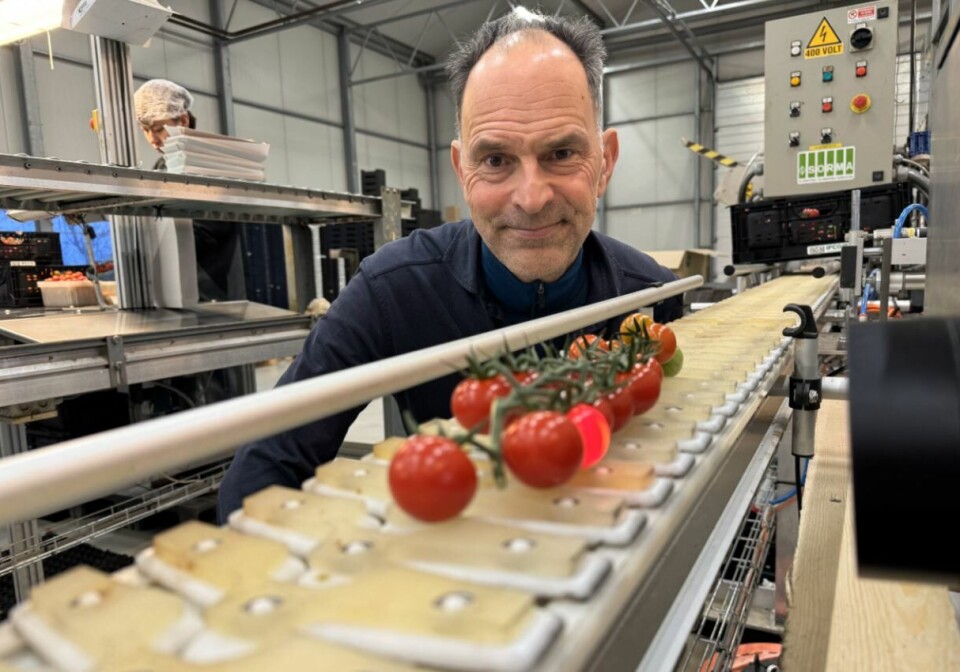THIS CONTENT IS BROUGHT TO YOU BY Nofima The Norwegian Institute of Food, Fisheries and Aquaculture Research - read more
These sensors can tell how sweet tomatoes are
Deep red cherry tomatoes do not always taste sweet and fresh. Dissatisfied customers might therefore choose another type of tomato next time.

This is a situation Wiig Gartneri wants to avoid. They produce Piccolo tomatoes, red cherry tomatoes that are extra sweet.
They know that the red colour is not a guarantee of sweetness.
Now they want to use sensor technology to ensure that all the tomatoes they deliver to stores taste just as sweet and fresh as customers expect.
Spot checks can give incorrect answers
The sweetness in tomatoes comes from the fruit sugar.
Today, sweetness is measured through so-called Brix measurements. This is done by squeezing juice from the tomato and measuring the sugar concentration with an optical measuring instrument called a refractometer.
This method destroys the tomatoes and can therefore only be used for spot checks.
“We've discovered that sometimes Brix works poorly, without fully understanding why. At the same time, we see that NIR measurements consistently work well. It was the analyses carried out by Nofima's sensory assessors that made us discover that the Brix method can give deviating answers,” says Jens Petter Wold, who leads the research project DigiFoods and is a senior scientist at Nofima.
NIR spectroscopy uses near-infrared light to measure the contents of a sample. The advantage of such a sensor is that it measures quickly and does not damage the sample.
Taste tests confirm findings
In the work to develop calibrations that ensure the NIR sensors measure the correct sugar content, the researchers have compared results from NIR sensors, Brix measurements, and Nofima's sensory assessors panel.
The panel consists of 10 professional assessors. They analysed tomatoes that had undergone NIR measurements. The results are very consistent.
The 10 professional assessors at Nofima are a human instrument, and their measurements are far more nuanced than mechanical instruments. Their profession is to map and assess degrees of characteristics, preferably in food and drink.
Their analyses of the Piccolo cherry tomatoes show that several flavours accompany the sweet tomatoes. They have umami and an acidic taste. In this context, acid provides freshness. The sweet tomatoes also had a more fruity smell. At the other end of the flavour spectrum are the tomatoes with sour and green taste.
“It has been extremely useful to have the sensory panel involved in this research. Their results ensure that we can be confident that the sugar content we measure with NIR corresponds very well with sensory sweetness,” says Wold.
The sugar in the tomato is evenly distributed
The researchers also examined how the sweetness – the fruit sugar – is distributed in the tomatoes.
“We discovered that the sugar is evenly distributed in the tomatoes, and this is also of importance for how flexible Wiig can be in the choice of measuring instrument. When we know that the fruit sugar is fairly evenly distributed, we can also assume that it will work with measuring methods that do not measure as deeply into the tomatoes,” says Wold.
Testing sensors available on the market
The new NIR sensor, developed by researchers at SINTEF and Nofima, can measure well into a range of fruit and vegetables. This provides good and stable measurements of sugar in tomatoes. But as of today, there is no commercial instrument available.
DigiFoods partner NEO is now developing and testing a solution based on their commercially available hyperspectral (HySpex) cameras to bridge this gap.
With hyperspectral imaging of the surface using various wavelengths of light, researchers get detailed images of the raw materials.
“NEO has successfully tested this solution on tomatoes, creating a dedicated setup for in-line quality grading that delivers promising results. Given the semi-transparent nature of tomatoes, this setup appears to penetrate deeply enough to obtain reliable measurements,” says Lars Gidskehaug, solution manager at NEO.
One advantage of hyperspectral imaging is that it can show the sugar content in each individual tomato, which can be used to optimise quality selection and packaging of the tomatoes.
Measurements are made on the conveyor belt
When the tomato clusters are picked from the tomato plants in the greenhouse, they are placed on a conveyor belt.
Today, the employees assess whether the tomatoes are good enough based on colour and remove the ones they do not approve. These are used as animal feed.
We know that two tomatoes that look exactly the same can taste completely different. That is why the greenhouse wants a sensor to measure the sugar content in all the tomatoes.
Tomatoes that do not have the sweet taste customers want are removed manually before the approved ones are transferred to a cardboard container, ready for sale.

This content is paid for and presented by Nofima The Norwegian Institute of Food, Fisheries and Aquaculture Research
This content is created by Nofima's communication staff, who use this platform to communicate science and share results from research with the public. Nofima is one of more than 80 owners of ScienceNorway.no. Read more here.
More content from Nofima:
-
Red algae grown in wastewater from fish-farming facilities could become sustainable salmon feed
-
Pumpkins are good for more than just Halloween decorations
-
This is how temperature affects a salmon's health and growth
-
Study: Omega-3 and zinc is a powerful duo for salmon
-
Fish may turn yellow if frozen too fresh
-
Is it better if food is packaged in plastic or paperboard?





































